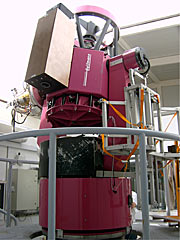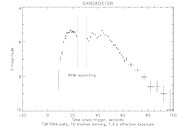Press Release
A Burst to See
Observing the distant Universe with the unaided eye
2 April 2008
On 19 March, Nature was particularly generous and provided astronomers with the wealth of four gamma-ray bursts on the same day. But that was not all: one of them is the most luminous object ever observed in the Universe. Despite being located in a distant galaxy, billions of light years away, it was so bright that it could have been seen, for a brief while, with the unaided eye.
Gamma-ray bursts (GRBs) are short flashes of energetic gamma-rays lasting from less than a second to several minutes. They release a tremendous quantity of energy in this short time making them the most powerful events since the Big Bang. It is now widely accepted that the majority of the gamma-ray bursts signal the explosion of very massive, highly evolved stars that collapse into black holes.
Gamma-ray bursts, which are invisible to our eyes, are discovered by telescopes in space. After releasing their intense burst of high-energy radiation, they become detectable for a short while in the optical and in the near-infrared. This 'afterglow' fades very rapidly, making detailed analysis possible for only a few hours after the gamma-ray detection. This analysis is important in particular in order to determine the GRB's distance and, hence, intrinsic brightness.
The gamma-ray burst GRB 080319B was detected by the NASA/STFC/ASI Swift satellite. "It was so bright that it almost blinded the Swift instruments for a while," says Guido Chincarini, Italian principal investigator of the mission. A bright optical counterpart was soon identified in the Boötes Constellation (the "Bear Driver" or "Herdsman"). A host of ground-based telescopes reacted promptly to study this new object in the sky. In particular, the optical emission was detected by a few wide-field cameras on telescopes that constantly monitor a large fraction of the sky, including the TORTORA camera in symbiosis with the 0.6-m REM telescope located at La Silla, able to record the event with unprecedented temporal resolution.
"These very early detections (just seconds after the beginning of the burst) showed the object to be so bright that it would have been visible just with the unaided eye," says Stefano Covino, from the REM team. "It was astonishing to see how rapidly the source varied during the observations," adds Sergey Karpov, of the TORTORA team.
Astronomers use the so-called magnitude scale, an inverse scale where fainter objects have larger magnitudes. In dark sites, the most acute of human eyes can distinguish sources as faint as magnitude 6. GRB 080319B was slightly brighter than this limit, although for just less than a minute.
The 8.2-metre ESO Very Large Telescope also reacted to the gamma-ray burst, thanks to a special procedure known as the rapid-response mode (see eso0717), which allows automatic observations with no human intervention. The high-resolution spectrograph UVES could collect exquisite data starting only 10 minutes after the burst, following requests by Fabrizio Fiore and his team. Another team then used also UVES to determine the distance of the burst.
"Despite its stunning brightness, the burst exploded in a galaxy 7.5 billion light years away," says Paul Vreeswijk, who led the second team. "It was therefore not only apparently bright, but also intrinsically very luminous. Indeed, it reached the brightest optical luminosity ever recorded for any astronomical object. For comparison, should the burst have exploded in our Galaxy, it would have lit up the night sky for several minutes as if it were daytime."
The TORTORA light curve of the event is available.
The team that determined the redshift from the UVES observations consists of Paul Vreeswijk, Alain Smette, Daniele Malesani, Johan Fynbo, Bo Milvang-Jensen, Páll Jakobsson, Andreas Jaunsen, Cédric Ledoux, Sara Ellison, Michael Andersen, Jens Hjorth, Andreas Kaufer, Palle Møller, Christina Thöne, Ralph Wijers.
The first team requesting UVES data on this burst comprises Fabrizio Fiore, Valerio D'Elia and Silvia Piranomonte.
The REM team is formed by G. Chincarini, E. Molinari, F.M. Zerbi, L.A. Antonelli, S. Covino, P. Conconi, L. Nicastro, E. Palazzi, M. Stefanon, V. Testa, G. Tosti, F. Vitali, A. Monfardini, F. D'Alessio, P. D'Avanzo, D. Fugazza, G. Malaspina, S.D. Vergani, S. Campana, P. Goldoni, D. Guetta, N. Masetti, E.J.A. Meurs, L. Norci, E. Pian, A. Fernandez-Soto, L. Stella, G. Tagliaferri, G. Ihle, L. Gonzalez, A. Pizarro, P. Sinclair, and J. Valenzuela.
The TORTORA team is formed by G. Beskin, S. Karpov, S. Bondar, A Guarnieri (TORTORA Italian PI), C. Bartolini, G. Greco, A. Piccioni, D. Nanni, F. Terra.
Contacts
Paul Vreeswijk
Dark Cosmology Centre University of Copenhagen
Copenhagen, Denmark
Tel: +45 3532 05 99
Email: pmv@dark-cosmology.dk
Daniele Malesani
Dark Cosmology Centre University of Copenhagen
Copenhagen, Denmark
Tel: +45 3532 59 81
Email: malesani@dark-cosmology.dk
Stefano Covino
INAF-Brera Astronomical Observatory
Brera, Italy
Tel: +39 039 999 11 66
Email: stefano.covino@brera.inaf.it
About the Release
| Release No.: | eso0808 |
| Legacy ID: | PR 08/08 |
| Name: | Rapid Eye Mount telescope |
| Type: | Unspecified : Technology : Observatory : Telescope |
| Facility: | Rapid Eye Mount telescope, Very Large Telescope |
| Instruments: | UVES |


